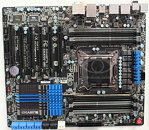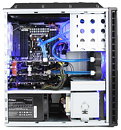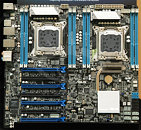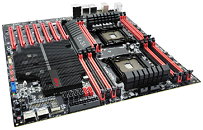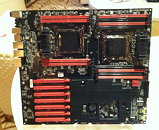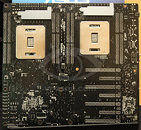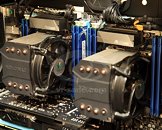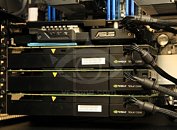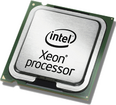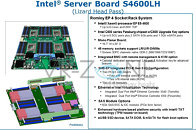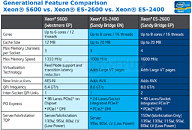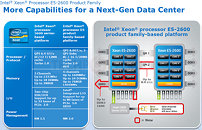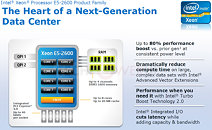Mar 26th, 2025 09:26 EDT
change timezone
Latest GPU Drivers
New Forum Posts
- Is RX 9070 VRAM temperature regular value or hotspot? (209)
- Should you physically remove secondary NVMe drives when performing a clean Windows install? (10)
- Discussion: linux-6.14.X (11)
- Has anyone tried enabling FSR 4 on NVIDIA cards? (18)
- Packing Ties vs. Cable/Zip Ties (3)
- The TPU UK Clubhouse (25959)
- Windows 10 Vs 11, Which one too choose? (104)
- Recommended PhysX card for 5xxx series? [Is vRAM relevant?] (220)
- any alternative to razer synapse to adjust mouse settings (5)
- What features do you want to see in a first person survival horror game? (40)
Popular Reviews
- Assassin's Creed Shadows Performance Benchmark Review - 30 GPUs Compared
- be quiet! Pure Rock Pro 3 Black Review
- ASUS ProArt X870E-Creator Wi-Fi Review
- ASRock Radeon RX 9070 XT Taichi OC Review - Excellent Cooling
- Pulsar Feinmann F01 Review
- Sapphire Radeon RX 9070 XT Nitro+ Review - Beating NVIDIA
- ASRock Phantom Gaming B860I Lightning Wi-Fi Review
- ASUS GeForce RTX 5070 TUF OC Review
- AMD Ryzen 9 9950X3D Review - Great for Gaming and Productivity
- AMD Ryzen 7 9800X3D Review - The Best Gaming Processor
Controversial News Posts
- AMD RDNA 4 and Radeon RX 9070 Series Unveiled: $549 & $599 (260)
- AMD Radeon RX 9070-series Pricing Leaks Courtesy of MicroCenter (158)
- MSI Doesn't Plan Radeon RX 9000 Series GPUs, Skips AMD RDNA 4 Generation Entirely (142)
- Microsoft Introduces Copilot for Gaming (123)
- AMD Radeon RX 9070 XT Reportedly Outperforms RTX 5080 Through Undervolting (118)
- NVIDIA Reportedly Prepares GeForce RTX 5060 and RTX 5060 Ti Unveil Tomorrow (115)
- Over 200,000 Sold Radeon RX 9070 and RX 9070 XT GPUs? AMD Says No Number was Given (100)
- NVIDIA GeForce RTX 5050, RTX 5060, and RTX 5060 Ti Specifications Leak (96)
News Posts matching #Sandy Bridge-EP
Return to Keyword Browsing
Ivy Bridge-E Not a Cut-down 8-core, 20 MB LLC Die
Unlike Core i7 "Sandy Bridge-E," chips, which were quad-core or six-core parts cut-down from a common silicon shared with Xeon "Sandy Bridge-EP," which physically features eight cores and 20 MB of L3 cache; the upcoming Core i7 "Ivy Bridge-E" is based on a silicon that physically features just six cores, and 15 MB (or maybe 16 MB) of L3 cache. On the Core i7-4960X Extreme Edition, practically no component on the die is disabled. The Core i7-4930K features just 12 MB of L3 cache, while the Core i7-4820K features two out of six cores disabled, and just 10 MB of L3 cache.
"Ivy Bridge-E" is a variant of one of three large 22 nm dies Intel designed, based on the "Ivy Bridge" micro-architecture, next to a 10-core die with 25 MB of L3 cache, and a 12-core die with 30 MB of L3 cache. Aside from up to six cores, "Ivy Bridge-E" features a PCI-Express gen 3.0 certified root-complex (certified in way that NVIDIA would approve of), and a quad-channel (256-bit wide) DDR3 integrated memory controller, with native support for DDR3-1866. Intel's Core i7 "Ivy Bridge-E" series should launch on or before the 10th of September. Parts in the series will run on existing socket LGA2011 motherboards, with a BIOS update.
"Ivy Bridge-E" is a variant of one of three large 22 nm dies Intel designed, based on the "Ivy Bridge" micro-architecture, next to a 10-core die with 25 MB of L3 cache, and a 12-core die with 30 MB of L3 cache. Aside from up to six cores, "Ivy Bridge-E" features a PCI-Express gen 3.0 certified root-complex (certified in way that NVIDIA would approve of), and a quad-channel (256-bit wide) DDR3 integrated memory controller, with native support for DDR3-1866. Intel's Core i7 "Ivy Bridge-E" series should launch on or before the 10th of September. Parts in the series will run on existing socket LGA2011 motherboards, with a BIOS update.

Gigabyte Unveils X79S-UD5 Workstation Motherboard
At CeBIT, Gigabyte unveiled what many may have overlooked for bearing a strong resemblance to the GA-X79-UD5, the GA-X79S-UD5. This board is designed to be a 1P workstation-grade motherboard, probably with out of the box support for the latest Xeon processors in the LGA2011 package, apart from Core i7 ones. The upper-half of this board is nearly identical to that of the X79-UD5. The LGA2011 CPU is powered by a 14-phase VRM, wired to eight DDR3 DIMM slots (two on either sides), supporting quad-channel memory. There are minor differences (as far as the upper-half is concerned). Tantulum capacitors on the X79-UD5 are replaced with cylindrical solid-state ones on the X79S-UD5, the FrescoLogic-made USB 3.0 controller is replaced with a VLI-made one.
It's the lower half of the X79S-UD5, where all the action is. The expansion slot load-out consists of five long PCI-Express x16 slots. Among these, two are PCI-Express 3.0 x16 capable, one is PCI-Express 3.0 x8 capable (by taking 8 lanes from one of the two x16 links), and two appear to be PCI-Express 2.0 x4. Then there's a legacy PCI slot. The PCH heatsink is identical to the one on the X79-UD5, but what's under it is what counts. Although named "X79"S-UD5, the board is actually based on the Intel C606 "Patsburg", which is an enterprise-grade chipset for Intel's Sandy Bridge-EP platforms. Apart from six SATA ports (2x 6 Gb/s + 4x 3 Gb/s), the C606 PCH provides eight SAS (Serial-attached SCSI) ports, running at 3 Gb/s speeds. The rest of the connectivity is completely identical to that of the X79-UD5.
It's the lower half of the X79S-UD5, where all the action is. The expansion slot load-out consists of five long PCI-Express x16 slots. Among these, two are PCI-Express 3.0 x16 capable, one is PCI-Express 3.0 x8 capable (by taking 8 lanes from one of the two x16 links), and two appear to be PCI-Express 2.0 x4. Then there's a legacy PCI slot. The PCH heatsink is identical to the one on the X79-UD5, but what's under it is what counts. Although named "X79"S-UD5, the board is actually based on the Intel C606 "Patsburg", which is an enterprise-grade chipset for Intel's Sandy Bridge-EP platforms. Apart from six SATA ports (2x 6 Gb/s + 4x 3 Gb/s), the C606 PCH provides eight SAS (Serial-attached SCSI) ports, running at 3 Gb/s speeds. The rest of the connectivity is completely identical to that of the X79-UD5.
Puget Systems Launches Sandy Bridge-EP Workstations and Servers
Puget Systems, a boutique integrator of custom PC systems for enthusiasts, gamers, consumers and SMB markets, today announced availability of Intel Sandy Bridge-E to its line of workstations and servers.
Sandy Bridge-EP incorporates improved memory bandwidth, more PCI-E lanes, and uses Intel's Turbo Boost Technology 2.0, providing even more performance when needed. For more information, a full Sandy Bridge-E technology primer is available from Puget Systems.
Sandy Bridge-EP incorporates improved memory bandwidth, more PCI-E lanes, and uses Intel's Turbo Boost Technology 2.0, providing even more performance when needed. For more information, a full Sandy Bridge-E technology primer is available from Puget Systems.

ASUS Z9PE-D8-WS Motherboard Up For Pre-Order
ASUS' dual-LGA2011 workstation motherboard, the Z9PE-D8-WS, has been listed by Canadian retailer NCIX for pre-order. It is priced at CA $632.98 (US $634.56). The store page does not go on to mention availability, except that orders will be shipped whenever there are inventories. Given its pre-order listing, we expect the product-launch of the Z9PE-D8-WS not to be too far, considering Intel's launch of a large number of "Sandy Bridge-EP" Xeon processors is just around the corner (within Q1, 2012). The Z9PE-D8-WS is designed to support 2P configurations based on Xeon "Sandy Bridge-EP" processors. The motherboard is further detailed here. To PC enthusiasts, it presents a potential alternative to EVGA's SR-X.Image Courtesy: VR-Zone

EVGA SR-X Dual-Socket LGA 2011 Motherboard Teased Some More
Wondering what's going on with EVGA's SR-X motherboard? Well the board still isn't ready for release but EVGA has made progress on it, as is confirmed by a new image provided by the US-based company. This photo showcases the SR-X in a near final stage, equipped with an updated cooling solution made up of four heatsinks (covering VRM areas and chipsets).
As previously reported, the SR-X comes with two LGA 2011 sockets (it supports Sandy Bridge-E CPUs for single-processor setups and Sandy Bridge-EP CPUs for dual-chip configurations), 12 DDR3 memory slots (up to 96 GB of RAM are supported), two (one 8-pin and one 6-pin) power connectors per CPU, six SATA and four SAS (Serial Attached SCSI) ports, seven PCI-Express 3.0 x16 slots (SLI and CrossFireX support is included), PCIe disable switches, voltage read points, a debug LED, dual Gigabit Ethernet, two eSATA ports, 7.1 channel audio, Bluetooth, EVBot support, and six USB 3.0 connectors (four on the back plate, two via a header).
EVGA is promising more details about the SR-X (a price tag and an availability date maybe) 'soon'. CeBIT anyone?
As previously reported, the SR-X comes with two LGA 2011 sockets (it supports Sandy Bridge-E CPUs for single-processor setups and Sandy Bridge-EP CPUs for dual-chip configurations), 12 DDR3 memory slots (up to 96 GB of RAM are supported), two (one 8-pin and one 6-pin) power connectors per CPU, six SATA and four SAS (Serial Attached SCSI) ports, seven PCI-Express 3.0 x16 slots (SLI and CrossFireX support is included), PCIe disable switches, voltage read points, a debug LED, dual Gigabit Ethernet, two eSATA ports, 7.1 channel audio, Bluetooth, EVBot support, and six USB 3.0 connectors (four on the back plate, two via a header).
EVGA is promising more details about the SR-X (a price tag and an availability date maybe) 'soon'. CeBIT anyone?

EVGA SR-X Dual-Socket LGA 2011 Motherboard Seen at CES
At this year's CES EVGA probably turned some heads with its upcoming power supply line but the company had more enthusiast eye candy on display, like the SR-X dual-socket motherboard. Teased a little last year, the SR-X seems to have the same HPTX form factor as its predecessor (the SR-2) but it offers support for the newest LGA 2011 Intel processors (Sandy Bridge-E for single-CPU setups, Sandy Bridge-EP for dual-CPU 'awesomesauce').
EVGA's dual-socket motherboard includes 12 DDR3 memory slots allowing for up to 96 GB of RAM, two (one 8-pin and one 6-pin) power connector per CPU, six SATA and four SAS (Serial Attached SCSI) ports, seven PCI-Express 3.0 x16 slots for SLI or CrossFireX configurations, PCIe disable switches, voltage read points, a debug LED, dual Gigabit Ethernet, two eSATA ports, 7.1 channel audio, Bluetooth, EVBot support, plus six USB 3.0 connectors (four on the back plate, two via a header). The SR-X still hasn't been priced or dated.
EVGA's dual-socket motherboard includes 12 DDR3 memory slots allowing for up to 96 GB of RAM, two (one 8-pin and one 6-pin) power connector per CPU, six SATA and four SAS (Serial Attached SCSI) ports, seven PCI-Express 3.0 x16 slots for SLI or CrossFireX configurations, PCIe disable switches, voltage read points, a debug LED, dual Gigabit Ethernet, two eSATA ports, 7.1 channel audio, Bluetooth, EVBot support, plus six USB 3.0 connectors (four on the back plate, two via a header). The SR-X still hasn't been priced or dated.

Xeon E5-2670 Seen Running on ASUS Rampage IV Gene
Imagine if your micro-ATX box that looks like you borrowed it from your mom and pop could crush every other machine twice or thrice its size, at the LAN party. That's possible when you run an Intel Xeon E5-2670 processor paired with ASUS Rampage IV Gene motherboard, as VR-Zone found out. Based on the Sandy Bridge-EP silicon the Xeon E5-2670 packs 8 cores, 16 threads enabled with HyperThreading, 8 x 256 KB L2 cache, and 20 MB shared L3 cache, and a quad-channel DDR3 IMC supporting up to 128 GB of RAM. ASUS managed to slip the right microcode into the BIOS running Rampage IV Gene, letting it run the chip. The Xeon E5-2670 will be clocked at 2.6 GHz, with a TDP of 115W. "Real men use real cores," go tell that to AMD.

ASUS Dual-Socket LGA2011 Motherboard Pictured
At CES, ASUS showed off its latest workstation motherboard designed for 2P socket LGA2011 Sandy Bridge-EP eight-core processors, the Z9PE-D8-WS. By the looks of it, it might not be having the voltage-delivery muscle of EVGA's SR3, but it is filled to the brim with connectivity. Each socket is powered by a 14-phase Digi+ II VRM, there are numerous other power domains. The board draws power from a 24-pin ATX connector, two 8-pin EPS connectors, and a 4-pin Molex.
The sockets are each wired to four DDR3 DIMM slots, giving this board the ability to hold up to 256 GB of RAM. There are seven PCI-Express 3.0 x16 expansion slots, from which four (blue) are x16 capable, and three (black) x8 capable. There are as many as 10 SATA ports, of which six appear to be 6 Gb/s capable. In terms of connectivity, an ASpeed AST2300 provides basic display and management over IP functions; there are two gigabit Ethernet interfaces driven by Intel-made controllers, two USB 3.0 ports, 8-channel HD audio, and a number of USB 2.0 ports. ASUS demonstrated this board by running two 2P capable unknown processors, three latest NVIDIA Tesla GPU compute cards, and an ASUS-made graphics card. Unlike with EVGA SR3, which is technically a workstation motherboard designed for enthusiasts, the Z9PE-D8-WS is intentioned to be a workstation motherboard only.
The sockets are each wired to four DDR3 DIMM slots, giving this board the ability to hold up to 256 GB of RAM. There are seven PCI-Express 3.0 x16 expansion slots, from which four (blue) are x16 capable, and three (black) x8 capable. There are as many as 10 SATA ports, of which six appear to be 6 Gb/s capable. In terms of connectivity, an ASpeed AST2300 provides basic display and management over IP functions; there are two gigabit Ethernet interfaces driven by Intel-made controllers, two USB 3.0 ports, 8-channel HD audio, and a number of USB 2.0 ports. ASUS demonstrated this board by running two 2P capable unknown processors, three latest NVIDIA Tesla GPU compute cards, and an ASUS-made graphics card. Unlike with EVGA SR3, which is technically a workstation motherboard designed for enthusiasts, the Z9PE-D8-WS is intentioned to be a workstation motherboard only.

Intel to Roll Out 40 New Server Processors in H1 2012
With key enterprise architectures such as Sandy Bridge-EP awaiting launch, Intel has as many as 40 Xeon processor models to release in the first half of 2012, which it will likely launch in two rounds of 20 models, for each of the first two quarters of this year. In Q1, Intel will release six-core Xeon E5-1660 and E5-1650, and a yet to be named quad-core model; the three will be priced at US US$1,080, US$583 and US$294, respectively. In the same quarter, Intel will also launch 7 eight-core Xeon processor models, including the Xeon E5-2690four six-core processors including E5-2640, three quad-core processors including E5-2609 and dual-core processor E5-2637. Intel will also launch some low-power (energy-efficient) Xeon models, including Xeon E5-2450L and six-core E5-2430L priced at US$1,106 and US$662.
In the second quarter of 2012, Intel will launch the other 20 models. These include Xeon processors based on the Ivy Bridge silicon, and in the socket H2 (LGA1155) package. The Xeon E3-1290v2 is an example of such a chip. These high-grade Ivy Bridge chips will be priced in the range of US$189-884. Then on, 7 more E5 series models will be launched, including Xeon E5-2470, priced between US$192-1,440. Towards the end of the quarter, Intel will launch low-power eight-core and six-core Xeon processor models, including Xeon E5-2650L and E5-2630L, priced at priced at US$1,106 and US$662, respectively.
In the second quarter of 2012, Intel will launch the other 20 models. These include Xeon processors based on the Ivy Bridge silicon, and in the socket H2 (LGA1155) package. The Xeon E3-1290v2 is an example of such a chip. These high-grade Ivy Bridge chips will be priced in the range of US$189-884. Then on, 7 more E5 series models will be launched, including Xeon E5-2470, priced between US$192-1,440. Towards the end of the quarter, Intel will launch low-power eight-core and six-core Xeon processor models, including Xeon E5-2650L and E5-2630L, priced at priced at US$1,106 and US$662, respectively.

New Intel Server Board to Hold 1 TB of RAM
Intel is working on a new four-socket LGA2011 Server Board product, S4600LH (codename "Lizard Head Pass"), which is capable of holding a total of 1 terabyte of RAM. It is designed mainly for high-performance computing and math-intensive server applications, such as video streaming sites using it for transcoding, etc. The board is able to achieve such large memory expansion room, by providing three DIMM slots per memory channel. Each socket gives four memory channels.
The board supports 8-core Xeon E5-4600 series Sandy Bridge-EP processors. It is driven by Intel C600 "Patsburg" chipset with up to 8 SCU ports and 2 SATA 6 Gb/s ports. There are no standard expansion slots on the board as such, but there are two PCI-Express 3.0 x48 risers, to which daughterboards with three x16 slots each, can be attached (as shown in the CGI drawing below). Apart from these PCIe x48 risers, there is one PCIe 3.0 x8 I/O module on board. The board features dual Intel LAN with VT support. KVM and BMT logic is in-built. The Server Board S4600LH from Intel will be available in Q2 2012.
The board supports 8-core Xeon E5-4600 series Sandy Bridge-EP processors. It is driven by Intel C600 "Patsburg" chipset with up to 8 SCU ports and 2 SATA 6 Gb/s ports. There are no standard expansion slots on the board as such, but there are two PCI-Express 3.0 x48 risers, to which daughterboards with three x16 slots each, can be attached (as shown in the CGI drawing below). Apart from these PCIe x48 risers, there is one PCIe 3.0 x8 I/O module on board. The board features dual Intel LAN with VT support. KVM and BMT logic is in-built. The Server Board S4600LH from Intel will be available in Q2 2012.

Intel Xeon E5-2690 Sandy Bridge-EP Performance Leaked
We sourced a presentation, allegedly by Intel, detailing its Sandy Bridge-EP platform, and giving out early performance figures. After successful and trouble-free launches of its Sandy Bridge architecture across all PC form-factors, including the recently-launched Core i7 "Sandy Bridge-E" HEDT (high-end desktop), Intel is taking the architecture to its ultimate market, enterprise, where processors derived from it will make up new lines of Intel Xeon processor families. Intel has two branches of enterprise variations the architecture, Sandy Bridge-EN, designed for high-density, low-power servers, and Sandy Bridge-EP, designed for high-performance servers and workstations. Sandy Bridge-EP is multi-socket capable.
Sandy Bridge-EP uses essentially the same piece of silicon as Sandy Bridge-E, but enabled with several of its features otherwise off limits to the Core processor family. These include twoQuickPath Interconnect (QPI) links, which facilitate high-bandwidth inter-socket communication in multi-socket systems, up to eight cores, sixteen threads enabled by HyperThreading, and up to 20 MB of L3 cache memory. Like its Core family cousins, Xeon Sandy Bridge-EP packs a quad-channel DDR3 integrated memory controller, and PC3-12800 (DDR3-1600 MHz) is its optimal memory standard, but unlike it, supporting up to 768 GB of memory (by two sockets, eight DDR3 channels in all, LRDIMMs). Other key features are listed in the first slide below.Performance figures follow.
Sandy Bridge-EP uses essentially the same piece of silicon as Sandy Bridge-E, but enabled with several of its features otherwise off limits to the Core processor family. These include twoQuickPath Interconnect (QPI) links, which facilitate high-bandwidth inter-socket communication in multi-socket systems, up to eight cores, sixteen threads enabled by HyperThreading, and up to 20 MB of L3 cache memory. Like its Core family cousins, Xeon Sandy Bridge-EP packs a quad-channel DDR3 integrated memory controller, and PC3-12800 (DDR3-1600 MHz) is its optimal memory standard, but unlike it, supporting up to 768 GB of memory (by two sockets, eight DDR3 channels in all, LRDIMMs). Other key features are listed in the first slide below.Performance figures follow.
Mar 26th, 2025 09:26 EDT
change timezone
Latest GPU Drivers
New Forum Posts
- Is RX 9070 VRAM temperature regular value or hotspot? (209)
- Should you physically remove secondary NVMe drives when performing a clean Windows install? (10)
- Discussion: linux-6.14.X (11)
- Has anyone tried enabling FSR 4 on NVIDIA cards? (18)
- Packing Ties vs. Cable/Zip Ties (3)
- The TPU UK Clubhouse (25959)
- Windows 10 Vs 11, Which one too choose? (104)
- Recommended PhysX card for 5xxx series? [Is vRAM relevant?] (220)
- any alternative to razer synapse to adjust mouse settings (5)
- What features do you want to see in a first person survival horror game? (40)
Popular Reviews
- Assassin's Creed Shadows Performance Benchmark Review - 30 GPUs Compared
- be quiet! Pure Rock Pro 3 Black Review
- ASUS ProArt X870E-Creator Wi-Fi Review
- ASRock Radeon RX 9070 XT Taichi OC Review - Excellent Cooling
- Pulsar Feinmann F01 Review
- Sapphire Radeon RX 9070 XT Nitro+ Review - Beating NVIDIA
- ASRock Phantom Gaming B860I Lightning Wi-Fi Review
- ASUS GeForce RTX 5070 TUF OC Review
- AMD Ryzen 9 9950X3D Review - Great for Gaming and Productivity
- AMD Ryzen 7 9800X3D Review - The Best Gaming Processor
Controversial News Posts
- AMD RDNA 4 and Radeon RX 9070 Series Unveiled: $549 & $599 (260)
- AMD Radeon RX 9070-series Pricing Leaks Courtesy of MicroCenter (158)
- MSI Doesn't Plan Radeon RX 9000 Series GPUs, Skips AMD RDNA 4 Generation Entirely (142)
- Microsoft Introduces Copilot for Gaming (123)
- AMD Radeon RX 9070 XT Reportedly Outperforms RTX 5080 Through Undervolting (118)
- NVIDIA Reportedly Prepares GeForce RTX 5060 and RTX 5060 Ti Unveil Tomorrow (115)
- Over 200,000 Sold Radeon RX 9070 and RX 9070 XT GPUs? AMD Says No Number was Given (100)
- NVIDIA GeForce RTX 5050, RTX 5060, and RTX 5060 Ti Specifications Leak (96)
